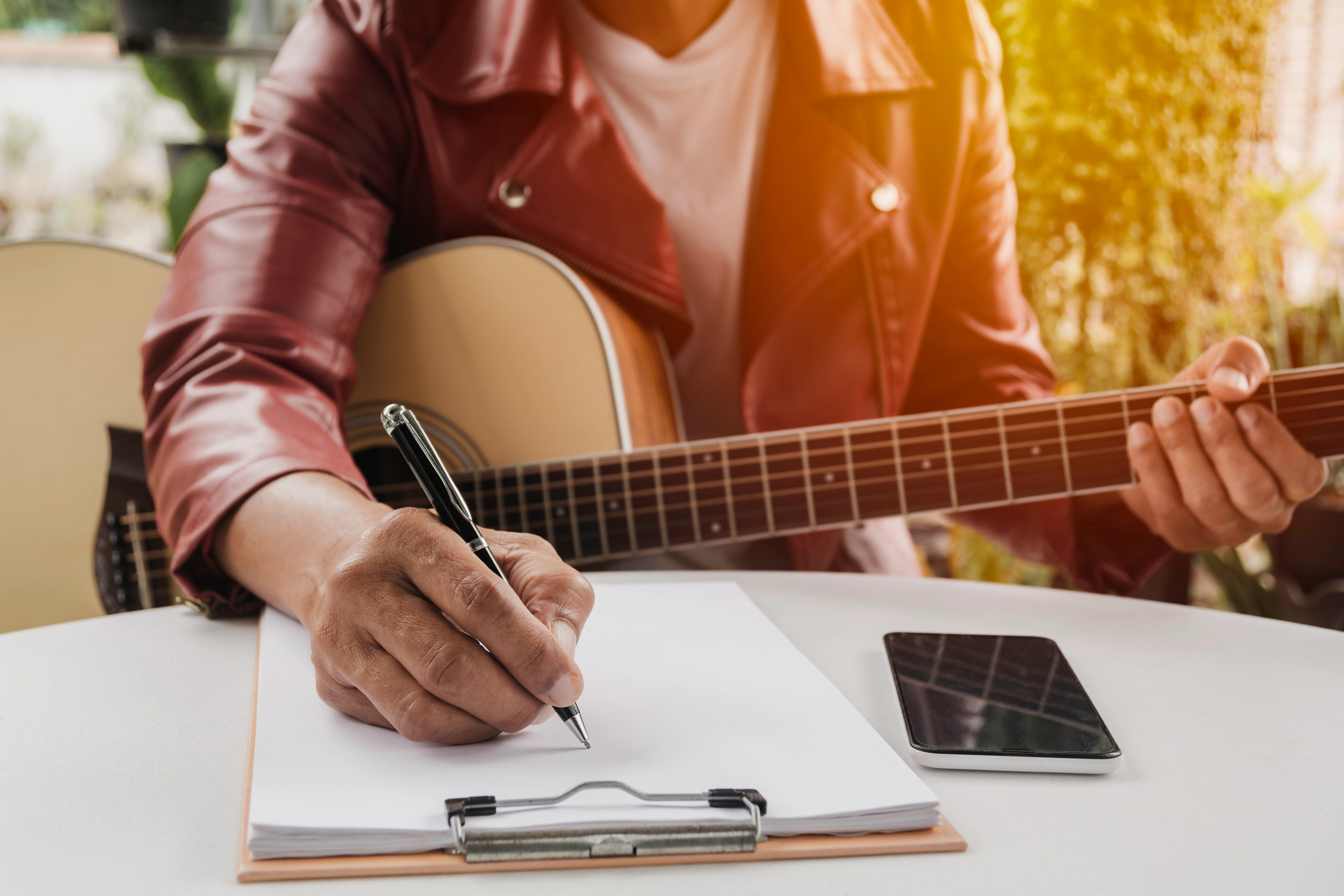This is one of the most commonly asked questions that pops up in the minds of any aspiring guitarist who’s just picked up the instrument. Many take that next step and attempt to learn guitar, only to give up a few months later. The urge to see instant progress and the expensive costs of learning the guitar can add to the frustration. However, regardless of all these, there’s no better feeling than strumming the strings seamlessly at the end of a course!
Through this article, we’ll address some of the most commonly asked questions, from purchasing the right guitar to understanding the correct methods of learning to play the guitar. We will also cover the intricacies of playing guitar, choosing the right guitars, understanding the basics, getting beginner tips, creating a practice routine, and many more. So, let us dive straight into how to play guitar for beginners. it.
How To Choose The Right Guitar For Beginners
At Artium, we believe the first step towards learning guitar is the instrument itself. Personal preference, price, style, and age are detrimental to these.
Based on our experience and most people’s experience worldwide, the acoustic guitar is the best for a beginner and aspiring musician like yourself. They are easy to handle and require no extra equipment, which makes them ideal for novices. On the other hand, classical guitars have design constraints that make it difficult for young guitar players or physically smaller individuals to handle when learning to play guitar chords or progressions. Even for electric guitars, an amplifier is a must, which again costs extra. As for the question of where to buy a guitar? We recommend that you buy it from a local music retail shop. These shops have experienced musicians who can help you choose the right ones. If purchasing online, buy only from a reputed company. In either case, make sure you review their business’ return policy. Also, we recommend you avoid buying a guitar from a pawn shop, flea market or yard sale purchases, so that you don’t end up with a faulty guitar. With respect to price, an average starting range of quality guitars is Rs. 8000 – Rs. 16000, while great guitars can cost anywhere between Rs.25,000 – Rs. 40,000 and more.
Guitar Basics: Understanding the Parts and Functions
Starting your guitar journey can be exciting yet challenging. To master how to play guitar, it’s essential to familiarise yourself with its different parts. Here’s a quick guide:
- Headstock:
Located at the top, the headstock features tuners and tuning pegs. These pegs allow you to tune the guitar by tightening or loosening the strings.
- Neck:
The narrow middle section of the guitar is the neck. The white strip closest to the headstock is the nut. The front side of the neck is the fretboard, which has metal wires called frets that help you find the right spots for your fingers.
- Body:
The most significant part of the guitar is the body. It includes a hole in the middle called the sound hole. The bridge, saddle, and bridge pins on the body hold the strings.
- Strings:
Next, there are six strings on a guitar. The thickest string closest to you is the sixth string, while the thinnest one at the bottom is the first. The middle strings are the fifth, fourth, third, and second strings. The strings are named E, A, D, G, B, and E from the sixth string to the first.
It already sounds insightful, doesn’t it? Here are 7 essential tips to help you learn how to play guitar for beginners effectively.
- Finger Placement
Proper finger placement is vital. Aim to place your fingertips behind the frets to avoid muted notes and buzzing. Practice scales and chords regularly to build strength and precision.
- Chord Transitions
Smooth chord transitions are crucial. Start with simple two-chord exercises, focusing on accuracy. Use a metronome to keep a steady rhythm.
- Strumming Patterns
Different songs need different strumming patterns. Begin with basic downstrokes, then mix upstrokes and various rhythms to play more fluidly.
- Fingerpicking
Fingerpicking adds depth to your playing. Assign each finger to a specific string and practice plucking them individually. This technique is excellent for genres like folk and blues.
- Barre Chords
Barre chords are tricky but essential. Press multiple strings across the fretboard with one finger. Mastering these opens up new chord possibilities and keys.
- Palm Muting
Palm muting adds dynamics to your music. Lightly rest your palm on the strings near the bridge to create a muted, percussive sound. It’s helpful in many genres.
- Bends and Slides
Bends and slides add emotion to your solos. Bending raises a string’s pitch while sliding moves a note up or down the fretboard. Practice these for a more expressive sound.
How To Play Guitar Chords and Scales
You’ll often hear the words ‘guitar chords’ and ‘scales’ throughout your guitar journey. So, it’s essential to understand what it means.
A guitar scale is simply playing the notes ascending or descending to improve your finger strength. It makes you more familiar with the notes on the fretboard, develops your ‘musical ear,’ and provides a framework for creating original melodies. Now, as for chords, you need chords to create harmony in music. They’re the stepping stones to creating rhythm. Without them, music would feel incomplete. So, chords and scales are the basics for an aspiring guitarist like yourself. Make sure to perfect the basics on your way to becoming a guitarist. Read our blog, ‘An Introduction to Guitar Scales for Beginners,’ to understand more about guitar scales and how to add them to your daily routine.
Beginner Practice Routines To Learn How To Play Guitar
When you’re learning something new, it is always better to plan and structure it properly. This helps you focus on specific skills that you want to improve.
- Before you begin your guitar journey, assess your current knowledge, skills, and music theory. This will help you set realistic goals that meet your needs.
- Identify the guitar style you aspire to play. Be it rock, pop, jazz, etc., develop your skills and techniques based on your music preference.
- Always think of it as a journey rather than a destination. Break your goals into smaller and achievable steps. Focus on fundamentals and developing finger dexterity. This will take you a long way.
- Consistency is the key. Practice regularly, every day, for a specific time.
- In this digital age, you’ll find a lot of online guitar classes or courses that teach you at your own pace. These resources can structure your learning and offer valuable insights from experienced instructors.
- Learning to play the guitar becomes more enjoyable and motivating when you’re part of a community. Artium Academy is one such community with over 20,000+ music aspirants. Certified and designed by renowned Indian film score composer, Mr. Raju Singh, our online guitar courses have paved the way for some great guitarists worldwide. Through our community of musicians, we encourage all our students to share their progress, seek advice and connect with fellow musicians.
- Learning every skill comes with its share of challenges. The vital part is to understand that challenges are part of the process, and instead of getting frustrated, you should view them as opportunities to grow. At Artium, this is precisely what we do: we celebrate small victories.
Moving on, let’s address –
Common Guitar Mistakes And How To Avoid Them
- Incorrect posture & holding
Assuming your right hand is your lead hand for comfortable guitar playing, rest the guitar on your right leg, keep the fretboard vertical, and position your strumming hand on top. Place your left hand with the thumb behind the neck. Vice versa, if you are left-handed.
- Poor finger placement
Proper finger placement is crucial for learning how to play guitar. As a beginner, you should focus slowly on clarity and accuracy and avoid flattening fingers or adding excessive pressure on the frets. Rest assured, with consistent practice, you’ll improve speed, master various picking and strumming techniques, and ensure proper tuning.
- Ignoring rhythm and timing
Mastering rhythm and timing is crucial for delivering music with finesse, and online guitar classes can help refine these skills. A metronome, especially for beginners like you, enhances your sense of timing and keeps you in sync, preventing common issues such as playing out of tempo. The idea is to prioritise rhythm and timing in your practice to become a more confident and skilled guitarist.
- Skipping the basics
Learning music theory is like mastering the grammar of a new language, helping you progress faster and improvise confidently. The key is in the basics. It deepens your understanding of how sound works, including chords, scales, and their relationships. By embracing music theory, you’ll enhance your creativity, analyse songs better, communicate with musicians more effectively, and confidently improve your guitar-playing techniques.
- Inconsistent practice routine
Establish a regular practice routine with new and old lessons to enhance your guitar skills, build muscle memory, and improve proficiency. Consistency is vital, as it helps make complex movements automatic. Ensure to practise daily and revisit previous lessons to reinforce learning. We also suggest you stick to a solid routine that will maximise your potential and help you consistently improve over time.
- Focusing on perfection
Strive to be better than yesterday rather than on perfection. Celebrate your unique playing style and enjoy the learning process. Always embrace your mistakes and remember the journey matters the most. So stay confident and enjoy the process of learning to play the guitar.
Learning Guitar Online
Online guitar courses, like the one taught at Artium, offer freedom and flexibility to schedule lessons at your convenience and pace. Usually, these courses include immediate feedback, interactive tools and resources such as video tutorials and forums.
While choosing the suitable online guitar classes, consider the following:
- Ensure the instructors are experienced and qualified.
- Ensure the courses cover a range of skills and styles relevant to your goals.
- Check reviews, ratings and previous student feedback on course quality.
- Compare prices and ensure they offer value to your investment.
Learn To Play Guitar With Artium Academy
Artium is India’s leading online music education platform. With over 20,000 students, the Artium music community is spread worldwide. We offer top-notch music education courses per industry standards, ease of convenience, and realistic goal setting. Our state-of-the-art approach of amalgamating music with technology helps you learn to play the guitar with the latest tools and models.
Enrolling at Artium also comes with the following exclusive benefits, or as we call it, The Artium Edge:
- Artium Originals
A career launch pad for music learners in association with Warner Music.
- Artium Masterclass
Free, LIVE & interactive masterclass conducted by some of India’s legendary musicians like Sonu Nigam, KS Chithra and more, just for our students.
- Artium Superstar
An exclusive opportunity to perform at one of India’s most prominent musical talent programs and get recognised for your skills.
So, what are you waiting for?
Hop on your dreams, pick up your guitar, and fine-tune your original melodies.
Begin your musical journey with Artium Academy today.






.webp)









